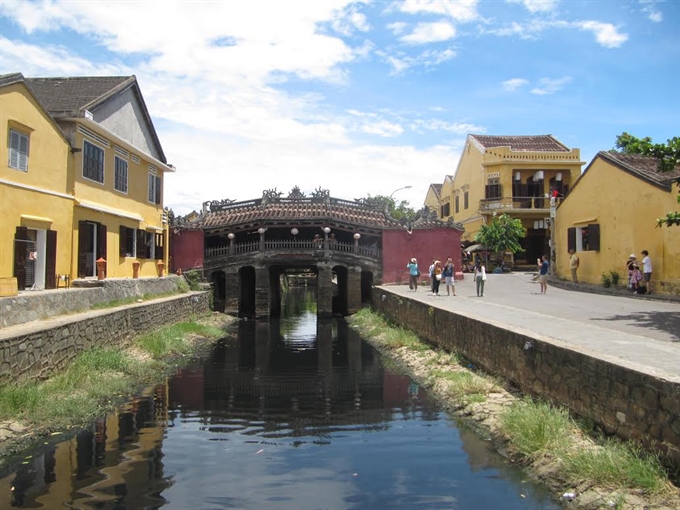 Life & Style
Life & Style

Positive and urgent measures are needed to review the restoration of the 400-year-old Japanese Bridge – a popular attraction and cultural symbol in Hội An – from collapsing.
 |
| The 400-year-old Japanese Bridge is a top tourist attraction and cultural symbol of Hội An City. Urgent measures are needed to restore the bridge and protect it from imminent collapse.-- VNS Photo Công Thành |
HỘI AN — Urgent measures are needed to review the restoration of the 400-year-old Japanese Bridge – a popular destination and cultural symbol in Hội An – from collapsing.
Experts, researchers and managers attended a symposium in Hội An yesterday to consider a solution for the ancient relic that has stood for the past four centuries.
The bridge, which was built and named by Lord Nguyễn Phúc Chu from the Nguyễn Dynasty in 1719, has undergone seven restorations, the latest completed in 1986.
Cracks in the foundations and main structure, timber girders, beams and rafters have been found in recent years due to the effects of time, erosion, floods and the impact of people using the bridge over many years.
“It’s very urgent. The bridge will collapse soon if we do not take emergency action. We found big hollows in the stone foundation, while joints and rafters on the upper structure were coming loose,” warned Nguyễn Xuân Toản from the Đà Nẵng Technology College.
“We had a survey on the damage of the bridge, and now propose a big restoration project for it,’ he said.
He explained that the upper structure of the bridge – arch timber floor, timber rafters and girders and the tile roof should be partly dismantled.
Toản said the measures had been applied at many historical relic restoration projects, and it would keep the origin and spirit of the bridge intact, whilst allowing it to stand for longer.
“The bridge, which was built with a strong stone structure foundation in combination with an upper wooden structure, must be dismantled for detailed reparations,” Toản said.
Architect Lê Thành Vinh, director of the Institute for Conservation of Monuments under the Ministry of Culture, Sports and Tourism, suggested the restoration must ensure the transport utility of the bridge as it has for centuries.
He said the bridge should ease its capacity by limiting the number of people crossing at a given time, while the floor of the bridge needs supports to reduce the impact on its foundations.
Vinh also said the restoration must involve the participation of top international experts.
Hiromichi Tomoda, professor from Showa Women’s University, said Japanese experts had good co-operation with Hội An in the preservation of relics in the ancient town for years.
He said Japanese merchants came to the town in the 16-17th century and a Japan Town was formed, and the bridge (known as the Japanese tile-covered bridge) and Japanese tombs have been preserved under the care of local residents.
“We are honoured to be invited to discuss the restoration of the bridge that we carried out a survey 20 years ago. I inspected the bridge last year and noted the seriousness of its damage,” Tomoda said.
“I hope a restoration plan will not impair the cultural value of the bridge, and we are ready to lend our experience to the restoration plan.”
Toshio Shimada from the Japanese Agency for Cultural Affairs said the agency will continue providing advice and information as requested from Việt Nam, and will send engineers to support Việt Nam for the restoration.
A former leader of Hội An, Nguyễn Sự, stressed that the restoration must keep the spirit of the bridge and the centuries-old design and architecture.
Spiritually, the bridge was built to link the sides of the channel in connection with the Hoài River, and it formed part of a strong belief among local people in the prevention against disaster and flood.
The bridge measures 20.4m long, 5.7m high and 13m wide, and hosts 4,000 visitors each day.
The bridge was also the centre of cultural exchange among Japanese, Chinese and Vietnamese from the late 14th century in the busy port town.
According to Hội An authorities, 85 per cent of ticket sales in the city were used to restore old houses and relics of the UNESCO-recognised world heritage sites.
The city also plans to build a waste water treatment station to improve the channel running under the Japanese Bridge from a fund from Japanese and Vietnamese governments. — VNS




